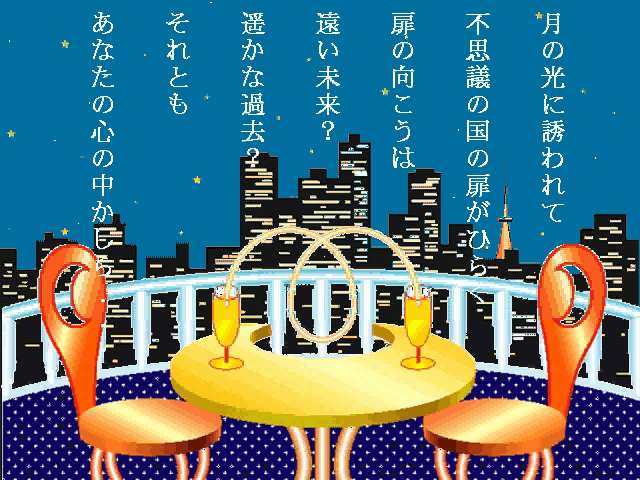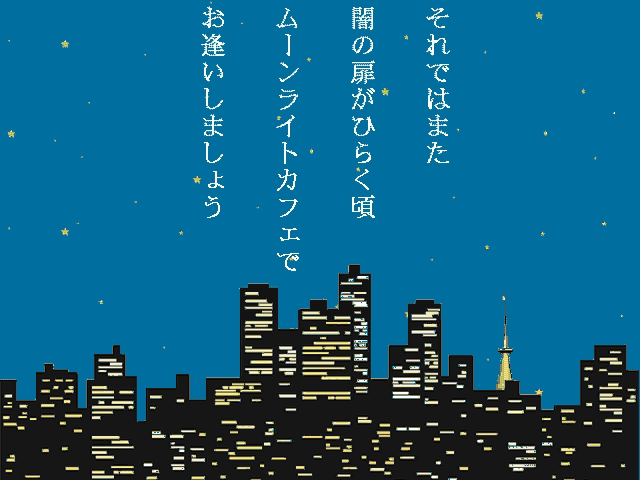Moon Light Café
Writing about early CD-ROMs means coming across a lot of early examples of things that became famous later. Sometimes that means finding new and exciting angles on something familiar... and sometimes it means something that's only notable for being early. Today's disc is one of those.

If not for the sticker on the shrinkwrap warning the listener not to play track 1 on a CD player, Moon Light Café might look like any other self-titled single from a band you've never heard of. The minimalistic graphic design of the cover doesn't really hint at its genre, but on the back cover, next to the list of three tracks, is system requirements for Mac and Windows. What kind of CD single needs a Mac or PC? (What kind of music CD tells you how not to play it before it tells you what kind of music it is?)
Let's ignore those system requirements for just a moment, since this does work in a regular CD player so long as you follow the instructions and ignore the first track. Unlike most CD singles, however, it doesn't open with the A-side; it begins with an inoffensive but fairly dull easy listening instrumental track. It runs for two minutes before reaching the CD's actual A-side, Tokimeki, a pleasant and forgettable J-pop track with a laid-back tone, and closes out with another two-minute long easy-listening track. A music reviewer might struggle to say much about the disc, positively or negatively; it's simply a nondescript, disposible object like many other CDs of that era.But, of course, this isn't Audio CD Journal—if this were just a CD single with a little bit of forgettable music, it wouldn't be here. The system requirements printed on the back make it clear there's something else going on. Pop it into a Mac or Windows computer, and you're presented with something different: a set of videos. The viewer's invited to watch these in order—an opening sequence, followed by a music video for Tokimeki, and an ending sequence. The entire thing runs a breezy nine minutes and can be watched right here.
Watching the video provides some extra context on just what those two instrumental easy-listening tracks were. Those opening and ending sequences provide something like a frame story for the song—that the Moon Light Café is a place where lonely hearts can go to dry their tears, and where you can always return should you need it. What seemed like totally out-of-place tracks when listened to on the CD player suddenly make sense when watched as a video.
And then there's the music video itself, which is a surprisingly lo-fi affair. Full-motion music videos were very much possible at this time—Windows 95 shipped with a full Weezer music video just the year before!—but this isn't anything like that. Instead, we're given a Powerpoint-style slide show that repeatedly pans between a few photos of the singer, Ai Orikasa, in the recording studio them. It's not quite strange enough to be charming as kitsch, but it's also not really genuine enough to work as a standalone video either.
The animation in the opening and ending sequences would have been cutting edge in 1991, but by 1996 would have been considered fairly crude. (Of course, in 2025, it's all wrapped around again and this limited animation has its charms.) The storyline and presentation of the wrapping elements does add a bit to the whole package, but it also raises questions of what exactly the broader project was meant to be. There's not that much of a relationship between the intro message and the song, and the daggy digital Moon Light Café animation we see in the opening and intro doesn't really have much connection to the music video for the song. Was this meant to be a light bit of story that would have connected different singles from the same label?

The actual animation for these three tracks looks very much like early Director animations, but they're actually presented as prerendered QuickTime video files on the disc. A slightly unusual choice in 1996; even at this point, real-time Director animation would have run much better than full-screen 640x480 QuickTime videos. (This may be why the video runs at a generous 8 frames per second.) The jewel case lists no fewer than three programmers for this less-than-nine minute video, which suggests grand plans for an interactive version that absolutely didn't happen. The disc's minimalistic layout—a few video files, a copy of QuickTime, and a README, with no "play now" executable or any interactive content—feels like a compromise, not so much a design decision as a product kicked out the door when the designers struggled to get their original plan running on both Mac and Windows.
How did this even happen? Why would a CD single come with these videos? Well, it's hard to remember now, but the "enhanced CD" used to be a really big deal. These were audio CDs that could be played in a regular CD player, but which had extra features when put into a computer—music videos, behind the scenes footage, interactive content. For about a decade from the late 90s through the late 00s, they were genuinely quite common. A decent percentage of major label CDs from the late 90s through the late 00s had some kind of bonus content on them... but not out of the generosity of their hearts. It was because of Napster.
Napster, for those who might be a bit too young to remember, was the first mainstream music piracy program and it completely revolutionized music piracy overnight. Pirating an album used to mean mean waiting for it to come on the radio or borrowing your friend's tape to copy it, but now you didn't even need to know anyone else with the album. You could just type the name into a search bar and you could easily get anything you wanted for free.
Music companies were terrified. Since it seemed like anyone could get any music they wanted for free without a second thought, record companies struggled to find ways to incentivize people to keep buying CDs. Aside from suing everyone they could find (which they did), they started looking into extras, bonus features, anything at all to make CDs seem worth it. The actual content on these discs could run anything from a generic app with a video or two to an entire Sarah McLaghlan multimedia application. (Trust me, in the late 90s that seemed cool. To the right person it's still cool!)
But the unifying feature of all of these discs was that the focus was the CD. The music. Enhanced CDs were successful because they were a sweetener to encourage you to buy a CD you were already planning to listen to instead of pirating it. Moon Light Café seems to have instead been an attempt to use the enhanced CD content to entice people to buy a CD they wouldn't have ever heard of... and by all signs it didn't work.
Of course, Moon Light Café didn't invent the idea. The first enhanced CDs came out alongside the CD-i in 1991; these worked in a standard CD player, like other enhanced CDs, but the bonus content was meant to entice people to buy a CD-i player rather than the discs themselves. Unsurprisingly this didn't sell many discs or players, though some of these discs are interesting on their own. The format was mostly dormant for the period between those early releases and Napster, with most "musician CDs" being full multimedia discs of their own rather than bonus features on regular albums. Moon Light Café was almost late enough to come during for the enhanced CD renaissance, but instead was released nearly all on its lonesome.
But who made it? The core attraction, the A-side Tokimeki, was sung by singer Ai Orikasa. She's primarily known as a voice actor, perhaps most familiar in the west for her role as Ryoko in the long-running Tenchi Muyo series. Like a lot of voice actors she had a side gig as a musician, and seems to have had several albums to her name over the years. Moon Light Café seems to have been a one-off collaboration for her, and the rest of her albums (before and after) were released by more normal, mainstream labels. Since her name doesn't even feature on the cover art, it's not out of the question this was a work for hire and that her contract prevented them from using her name to market it.
As for the label itself, the "Moon Light Factory" seems to have disappeared after this one release. The disc features the serial number "MLF-0001", but I haven't seen any evidence there was even a second disc under this label. The album's composers moved on to other work in the anime music industry, rather than the pop music industry this CD seems to have been aimed at, while the album's other producers and programmers don't seem to have other professional credits in the music industry.

This all perhaps sounds a bit harsh, but I do have a real and abiding fondness in my heart for an interesting failure. This disc is clearly not what anyone involved wanted it to be, but there's something intriguing about the almost-clarity of the concept and the room to imagine what it could have been in other circumstances. Moon Light Café didn't live long enough to see its own format live again, but we can still visit from time to time. Can't we?